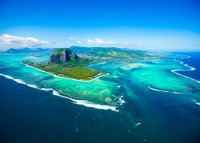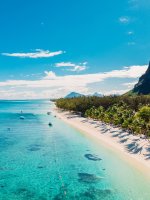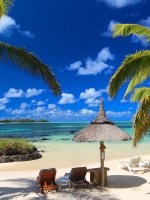Rodrigues shares its history with Mauritius although it was discovered later, in 1528, and retained the name of its Portuguese discoverer, Diego Rodriguez, throughout Dutch, French and British colonisation. Some historians maintain that it was discovered earlier, in 1507, by another Portuguese seafarer, Diego Fernandez de Pereira.
The Dutch paid little attention to Rodrigues and the first known settlers were French, although they came during the Dutch period. These were nine French Protestants fleeing from France, led by François Leguat. They had actually been trying to reach Ile Bourbon (Réunion) but stumbled upon Rodrigues in 1691 and found the island covered in luxuriant vegetation, with an abundance of birds and tortoises. After two years, the settlers made it to Mauritius, where Leguat was arrested on the orders of the Dutch governor and charged with amber trafficking.
In 1725, France decided to colonise Rodrigues in the name of Louis XV and sent eight soldiers, 13 planters and 15 slaves. The colonisation was unsuccessful, although some of the slaves remained when the French left. The French noted that Rodrigues suffered from more cyclones and higher winds than Ile de France, and had a difficult approach through rocks and shoals to the harbour they called Port Mathurin.
The first permanent settler was a master mariner, Germain le Gros, who arrived in September 1792 to engage in fishing and trading. He was followed in 1793 by Michel Gorry and Philibert Marragon, who had visited previously in 1791. Marragon and his wife lived at L’Orangerie until both died on Rodrigues in 1826. They, and several slaves, are buried at L’Union, near a monument to the slaves (see also page 221).
In the time-honoured manner of expatriates living on a small island, the three French settlers distrusted each other and soon fell out. Marragon was civil agent for the French Government, a position that did not deter him from entertaining and welcoming the crews of British ships when they put in for water and food, much to Le Gros’s annoyance.
The fraternisation of the settlers on Rodrigues with the British made the new governor of Ile de France, General Decaen, keen to replace Marragon and the others with his own island’s unwanted lepers. The plan failed. Marragon remained and the lepers went to Diego Garcia.
Marragon conducted a census in 1804 which shows the island’s population as 22 whites (about half of them actually of mixed race) and 82 slaves. The majority of the slaves were from Mozambique, yet nearly a third (24) were born in Rodrigues.
In 1794, Britain decided to capture Ile de France, but their attempts were limited to foraging expeditions to Rodrigues. They wanted to take Rodrigues too, and concentrated on building up good relations with the settlers by paying for their supplies instead of looting. By August 1809, they had no qualms about making their intentions known and landed the first of the forces being assembled to capture Ile de France: 200 infantry and 200 sepoys (Indian soldiers trained by the British).
The occupation of Rodrigues began enthusiastically, with Colonel Keating, who was in command, writing home: ‘These are some of the most delightful valleys I ever saw and the soil naturally rich in one of the finest climates in the world capable of producing every sort of vegetation and there is a sufficient quantity of land already cleared for cultivation and the feeding of cattle.’ Keating imported cattle and slaves from Madagascar as more British troops assembled.
In July 1810, a force of 4,000 left Rodrigues and went on to capture Ile Bourbon (Réunion) from the French. Following their unexpected defeat at Vieux Grand Port in August, the British gathered a large force in Rodrigues for their successful assault on Ile de France in December 1810. After that, the British occupied Rodrigues until April 1812 when they withdrew, leaving behind most of the 300 slaves they had imported. British rule of Rodrigues was confirmed by the Treaty of Paris in May 1814.
The first British settler was a young man called Thomas Robert Pye, a lieutenant of the marines at a loose end, who was sent by Governor Farquhar in 1821. He stayed only two years. When slavery was abolished, those slaves who had not emancipated themselves already promptly left their owners and squatted on crown land. They finally settled in the mountains where their descendants still live today.
In the mid 19th century, several Europeans or near-Europeans settled in Rodrigues, mostly in the lowlands. They included shipwrecked sailors and minor British civil servants who liked the island. Some of the British married Rodriguan women while others had affairs with them and, as the saying goes in Rodrigues, ‘left one or two portraits behind’.
The portraits and the mixed-blood population were centred on Port Mathurin, Baie aux Huîtres, Grand Baie and La Ferme. When the first steamer arrived in the 1890s, so did more settlers, including Indian and Chinese traders. By 1970, the Chinese owned 90% of all the shops on the island.
The growth of the population was rapid. As there were more men than women at first, most women had several partners, their children being raised as the children of the man of the moment. At the end of the 19th century, the population was 3,000. Twenty years later this had become 6,573. The population almost doubled in subsequent 20-year periods, becoming 11,385 in 1944, 18,587 in 1963 and 32,000 in 1981.
Rodrigues was administered as a dependency of Mauritius during the 158 years of British rule. Like a poor relation, it was mostly forgotten or neglected, with occasional official reports warning of the consequences of too large a population.
Since 1968, it has been an integral part of Mauritius. For many years Rodrigues sought greater autonomy over its affairs and on 12 October 2002 the newly created Rodrigues Regional Assembly met for the first time. The Assembly is made up of 21 members, plus its chairperson. At present the Organisation du Peuple Rodriguais (OPR) has a majority of ten members. While the assembly may initiate legislation, this must pass through the Mauritian National Assembly to become law. For further information, visit the Assembly’s website rra.gov.mu.














